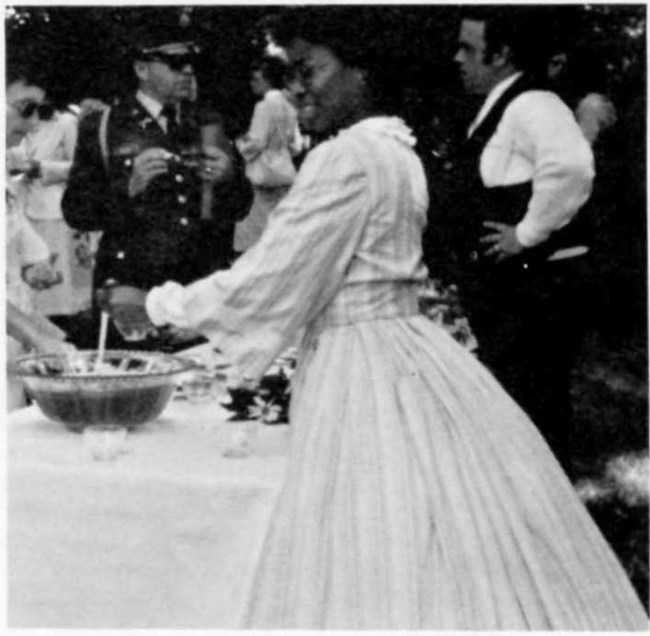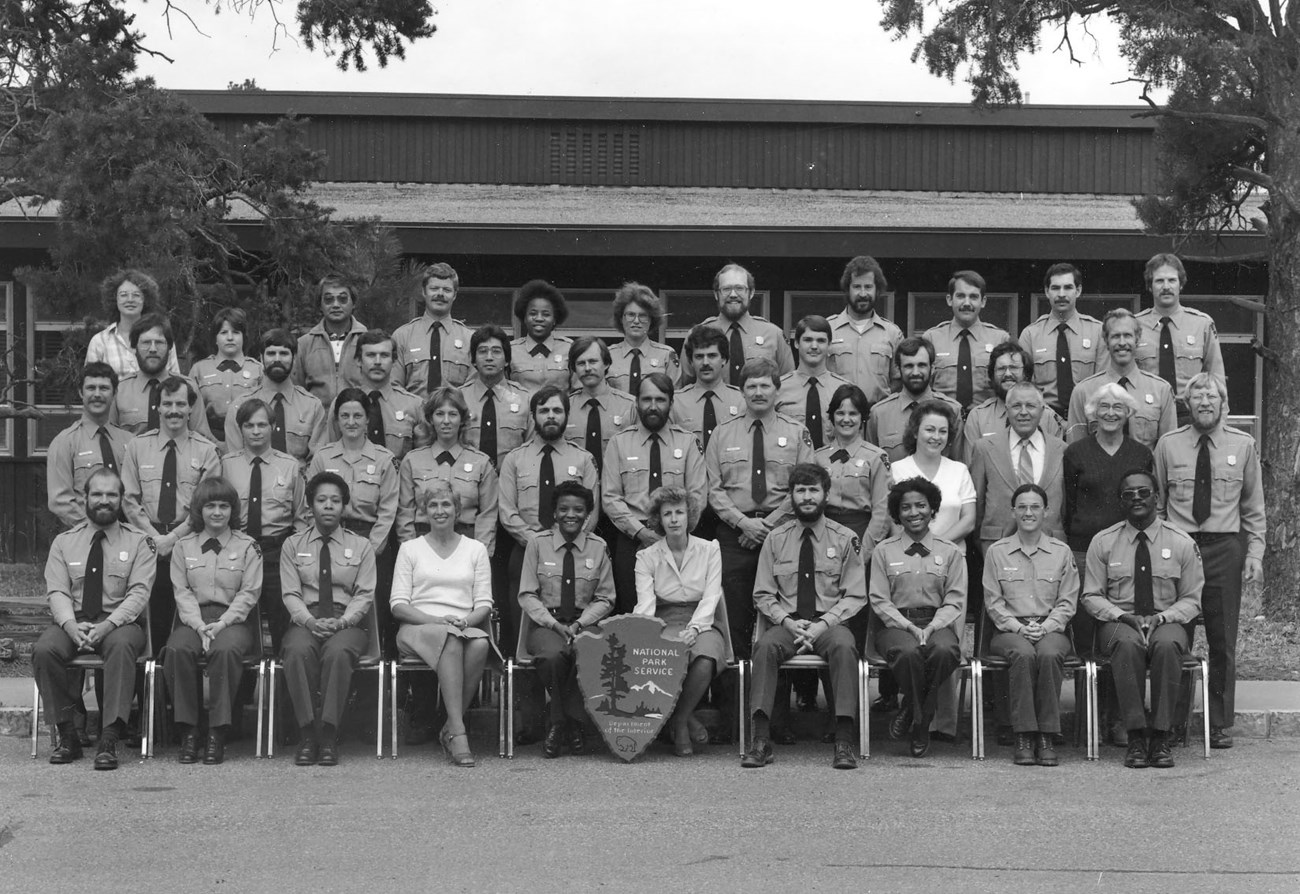Last updated: March 1, 2022
Article
Regina P. Jones Underwood Brake
History and service are family traditions for Regina Patricia Jones. Her father earned a Purple Heart during World War II and spent 35 years working for the Department of Defense. Her great-great grandfather served in the US 32nd Colored Troops during the Civil War.
A native Philadelphian, Jones attended La Salle College just two years after the college began accepting women as full-time students. She graduated with a degree in American history in 1977.
On New Year’s Eve 1975, she waited with her family in the rain to watch the Liberty Bell move from Independence Hall to the Bell Pavilion. In early 1976 she had a life-changing encounter with a Black woman ranger at Independence. She recalled in a 1985 oral history interview, “It was Geraldine Bell. She impressed me. I can still see her today. She was standing outside in front of Independence Hall. She had a walkie-talkie. There were tours all over the place. She was directing people this way and that. It was about quarter to five in the afternoon. There was a lot of bus traffic. I said, ‘Excuse me, I’m interested in what you do. Tell me about what you do.” She took the time to tell me what her position was and I thought, ‘This is it.’”
In spring 1976 Jones was hired as a park technician at Independence for the bicentennial of the Declaration of Independence. Her duties included working the front desk, giving tours at Franklin Court, and working as a printer in the Print Shop. In a 1977 oral history interview Jones recalled, “The females had to get [ranger] hats last summer and that was great because a lot of times a man would be standing there and undoubtedly the men would have the hats and the visitors would go to them. We would say ‘We know just as much.'”

Although the bicentennial visit of Queen Elizabeth II happened on Jones’s day off, she did experience the fourth of July fireworks. Her enthusiasm was evident a year later when she remarked, “I think I did more celebrating than working. I mean work seemed fun that day, extra fun! It was like a building up of excitement all week. It was a very long day and I was glad it was long. We were fortunate enough to take turns giving out pamphlets on Market Street where the festivities were. I was so caught up in it all because I had been looking forward to it for so long. Nobody seemed unhappy that day.”
She accepted a permanent position at Independence in 1977, the year she began graduate school at Temple University. In September 1978 she married David Underwood. He was in the US Air Force and was soon transferred to Mississippi. Unaware of parks near Biloxi, Jones-Underwood resigned from the NPS in 1978.
Once in Mississippi, however, she learned that Gulf Islands National Seashore in Florida had a Mississippi district. She went to the park superintendent, application in hand. She recalled, “I felt left out those six months that I was not affiliated with the Park Service. I even told the superintendent that I was willing to volunteer. I just needed to feel close the ‘green and gray’ [referring to the NPS uniform]. That’s how I felt after my experience at Independence.” With letters of support from her supervisors at Independence, she persevered and when a position became available at Gulf Islands in March 1979 she returned to the NPS as a park technician.
She described her time at the park as lonely. She was the only Black woman with a permanent position on staff; the only other women were two who had temporary seasonal positions. Jones-Underwood’s duties at the park included giving tours to up to 220 people on the boat trip to Fort Massachusetts, leading tours of the fort, working in the visitor center, and helping out in the campground. She also created the first children’s program at the park.
Family circumstances called her back to the Washington, DC, area the next year, and she left Mississippi without a job. She reached out to the NPS National Capital Region’s Federal Woman’s Program coordinator, who helped her find open positions. Within a month, Jones-Underwood was hired as a park technician at Arlington House, The Robert E. Lee Mansion, conducting tours in period costume. She only stayed at the park a year, citing repeated demeaning and racist comments from park visitors as the reason she left. She was the only African American on staff and recalled, “I didn’t expect people to react to me that way. After a while I said, ‘I’m not happy.’”
In March 1981 she transferred to President’s Park with a promotion, serving as White House liaison. In that role she welcomed over 6,000 visitors a day to the White House, led tours, and assisted with special events, humorously noting that her job included “keeping adults without kids out of the annual Easter egg roll.” She became a Federal Woman’s Program coordinator.
Jones-Underwood and her coworkers experienced terrorist events such as a Klu Klux Clan rally down Pennsylvania Avenue, the 1981 attempted assassination of President Ronald Reagan, and the 1982 bomb threat against the Washington Monument by a nuclear disarmament activist. “All the terrorism that went with the White House, I felt like I was law enforcement without a firearm. It made me aware and very suspicious of everyone. I was more aware of what a person was capable of doing.”

In 1982 she completed NPS ranger skills training at the Horace M. Albright Training Center at Grand Canyon National Park. There were about a dozen women in her class. Four, including Jones-Underwood and Judy Forte, were African American women. She also completed a temporary assignment at Santa Monica National Recreation Area in summer 1984, providing information about the NPS at the Los Angeles Olympics. Later in her career she would staff information booths at two subsequent Olympic Games.
She left President’s Park in 1984 to continue advancing her career, returning to Independence even though it meant living apart from her husband. She supervised 20 employees at Franklin Court, including some who trained her to work in the Printing Office in 1976. While at the park in 1985, Jones-Underwood spoke about public reactions to her. “I see more of the visitor’s bewilderment when they see me go through the park. I hear kids’ comments, ‘Gee, I didn’t know they had lady rangers.’ Or ‘Who’s that lady guard in that uniform?’ That make me feel like they are realizing we have been here for a while, we being females. . . I see more enlightenment and a realization by the public that the female is a ranger, that the Black female is part of that ranger series.”
She rejoined the Gulf Islands National Seashore team, this time in the park’s Florida district. Shortly after, Jones-Underwood left the NPS to briefly work for the Department of Defense. She rejoined the NPS in 1990 at Harry S Truman National Historic Site as chief of interpretation and visitor services.

In fall 1991 she returned again to Independence National Historical Park as supervisory park ranger, working as site manager for Edgar Allen Poe National Historic Site, Thaddeus Kosciusko National Memorial, Gloria Dei Church National Historic Site, and Deshler-Morris House. Four years later she accepted the position of management assistant to the NPS northeast regional director. During this period she completed a detail assignment to the Martin Luther King, Jr. National Historic Site and was involved in the expansion of the National Underground Railroad initiative. She also worked as management assistant at Valley Forge National Historical Park.
In 2000 Jones-Underwood was hired as the management assistant for Assateague Island National Seashore. In July that year she married fellow NPS employee Joe Rufus Brake, Jr. In a 2009 interview she reflected, “I don’t think I would have excelled at my career if it has not been for history. It’s in my DNA to tell the stories that aren’t always highlighted, and every national park has its own untold stories—that’s what fascinates me.” Jones-Brake retired in 2010 after 33 years of service.
Sources:
Ancestry.com. U.S., Public Records Index, 1950-1993, Volume 2 [database on-line]. Lehi, UT, USA: Ancestry.com Operations, Inc., 2010.
Avery, Ron. (1995, April 28). “Park ranger into history, and egg rolls.” Philadelphia Daily News, pp 14.
Jones, Regina and Layman, Lewis interview. (1977, August 10). The Bicentennial at Independence National Historical Park Oral History Project, 1976-1990, NPS History Collection, Harpers Ferry Center.
Jones-Underwood, Regina interview. (1985, June 13). Polly Kaufman Collection, NPS History Collection, Harpers Ferry Center.
Mullarkey, Colleen. (2009). “Making a Living by Reliving History.” La Salle Magazine, spring 2009, p. 15.
National Park Service. (1981, June). "People on the Move." Courier: The National Park Service Newsletter, 4 (6), 18.
National Park Service. (1984, October). "NPS mounts major information effort for Olympic Games participants." Courier: The National Park Service Newsletter, 29 (10), 1.
National Park Service. (1989, January). "Letters." Courier: The National Park Service Newsletter, 34 (1), 5.
National Park Service. (1989, October). "‘Big Event’ at Wilson’s Creek packs ‘em in." Courier: The National Park Service Newsletter, 3 (11), 10.
National Park Service. (1992, February). "NPS Goes to Vail." Courier: The National Park Service Newsletter, 37 (2), 9.
National Park Service. (1992, April). "News." Courier: The National Park Service Newsletter, 37 (4), 35.
National Park Service. (2010, Spring/Summer). "Class of 2010." Courier: The National Park Service Newsletter, 17 (2), 6.
Outside the Box LLC. (2017). The Ordinary Home of an Extraordinary Man: Administrative History of Harry S Truman National Historic Site Missouri.
Explore More!
To learn more about women and the NPS Uniform, visit Dressing the Part: A Portfolio of Women’s History in the NPS.
This research was made possible in part by a grant from the National Park Foundation.
Tags
- arlington house, the robert e. lee memorial
- assateague island national seashore
- edgar allan poe national historic site
- george washington memorial parkway
- gloria dei church national historic site
- gulf islands national seashore
- harry s truman national historic site
- independence national historical park
- martin luther king, jr. national historical park
- santa monica mountains national recreation area
- thaddeus kosciuszko national memorial
- valley forge national historical park
- women's history
- african american history
- nps history
- nps history collection
- hfc
